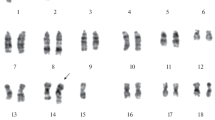Summary
Eight tumours of the central nervous system of the rat induced by NMU or 6.9.10-trimethyl-1.2-benzanthracene and one NMU-induced extracranial tumour were stained by the Feulgen method and fastgreen dye for cytophotometric determination of the DNA and histone content of the nuclei. From one NMU-induced intracranial sarcoma two successive transplant generations were measured.
The DNA and histone determinations of the sarcomas indicated (1 extracranial, 4 intracranial, 1 intramedullary) the tendency for development of a hyperdiploid DNA-stemline up to tetraploid levels. In our material only the second transplant generation of an intracranial sarcoma and an extracranial sarcoma reached this ploidy. As we suppose, the process of ploidy change in sarcomas of the central nervous system normally is interrupted by the premature death of the animal.
The two measured oligodendrogliomas induced by different carcinogens (NMU and 6.9.10-trimethyl-1.2-benzanthracene) show no deviations from the normal values.
In a glioblastoma multiforme the giant nuclei show high grades of ploidy. The histone content has no constant relation to the DNA values, which could be explained by degenerative processes.
Zusammenfassung
Die cytophotometrische Untersuchung des DNS- und Histongehaltes an 6 durch N-Methylnitrosoharnstoff induzierten Sarkomen (1 extrakraniell, 4 intrakraniell, 1 intramedullär) ergibt, daß an ihnen die Tendenz zur Herausbildung einer hyperdiploiden bis tetraploiden DNS-Stammlinie erkennbar wird. Dieser Ploidiegrad ist in unserem Material jedoch nur in dem extracraniellen Sarkom und der 2. Transplantatgeneration eines intracerebralen Sarkoms erreicht worden. Dieser Befund spricht dafür, daß in den anderen Fällen diese Entwicklung durch frühzeitigen Tod der Ratten infolge Schädigung des Zentralnervensystems unterbrochen wurde.
Die zwei untersuchten Oligodendrogliome, die durch verschiedene Carcinogene (MNH und 6.9.10-Trimethyl-1.2-Benzanthrazen) induziert wurden, zeigen keine Abweichungen vom Normalwert.
In einem Glioblastoma multiforme werden in den Riesenzellen hochgradige Polyploidien gefunden. Der Histongehalt zeigt keine konstante Relation zu den DNS-Werten, was durch degenerative Veränderungen erklärt wird.
Similar content being viewed by others
Literatur
Alfert, M., andI. I. Geschwind: A selektive staining method for the basic proteins of cell nuclei. Proc. nat. Acad. Sci. (Wash.)39, 991–999 (1953).
Bloch, D. P., andG. C. Godman: A microphotometric study of the synthesis of desoxyribonucleic acid and nuclear histone. J. biophys. biochem. Cytol.1, 17–28 (1955).
Boveri, T.: Zur Frage der Entstehung maligner Tumoren. Jena: Gustav Fischer 1914.
Gersch, M., J. Tappert, H. Meusinger u.J. Drawert: Über ein einfaches, im Eigenbau konstruiertes Zytophotometer, das den Anforderungen nach hoher Meßgenauigkeit entspricht. Acta histochem. (Jena)18, 137–142 (1964).
Grundmann, E., u.H. P. Hobik: Die Feulgen-Zytophotometrie im Karzinom und während der Karzinogenese. Acta histochem. (Jena), Suppl.6, 275–285 (1965).
Hauschka, T. S.: The chromosomes in ontogeny and oncogeny. Cancer Res.21, 957–974 (1961).
Jänisch, W., u.D. Schreiber: Experimentelle Geschwülste des Zentralnervensystems. Induktion, Morphologie, Transplantation und Anwendung. Jena: Gustav Fischer (im Druck).
——R. Stengel u.V. Steffen: Die Induktion von experimentellen Hirngeschwülsten bei Ratten mit Methylnitrosoharnstoff. Exp. Path.1, 243–255 (1967).
Jobst, K.: On the DNA and histone protein content of N-hitrosomethylurea induced tumors. Neoplasma (im Druck).
—, u.M. Kellermayer: Submicroscopic structure and dry weight of isolated thymus nuclei following trypsin and salt treatment. Acta morph. Acad. Sci. hung.15, 221–244 (1967).
Lederer, B., u.K. J. Lennartz: Cytophotometrische und autoradiographische Untersuchungen des Wachstums von Ascitestumoren. Z. Krebsforsch.70, 230–235 (1968).
Lennartz, K. J., u.W. Maurer: Autoradiographische Bestimmung der DNS-Verdopplung und der Generationszeit beim Ehrlich-Ascitestumor der Maus durch Doppelmarkierung mit C14- und H3-Thymidin. Z. Zellforsch.63, 478–495 (1964).
Leuchtenberger, C., u.R. Leuchtenberger: DNA in tumors and virus infections. In: Handbuch der Histochemie, Bd. III/3, S. 1–53. Stuttgart: Gustav Fischer 1966.
Magee, P. N.: Alkylation of nucleic acids and carcinogenesis. 17. Coll. Ges. Physiol. Chemie, S. 79–95. Berlin-Heidelberg-New York: Springer 1966.
Rohrbach, R., E. Hecker u.W. Sandritter: Cytophotometrische Messungen des DNS-Gehaltes der Epidermis nach unspezifischen cocarcinogenen und carcinogenen Reizen. Z. Krebsforsch.70, 211–221 (1968).
Sandritter, W.: DNA content of tumors. Cytophotometric measurements. Europ. J. Cancer1, 303–307 (1965).
—I. Hilwig, K. Engelbart, G. Kiefer u.R. Kiefer: Versuche zur Carcinogenese in vitro. Chromosomenanalysen und cytophotometrische Messungen des DNS-Gehaltes. Z. Krebsforsch.67, 57–68 (1965).
—, u.D. Kleikhans: Über das Trockengewicht, den DNS- und Histonproteingehalt von menschlichen Tumoren. Z. Krebsforsch.66, 333–348 (1964).
Seidel, A., u.W. Sandritter: Cytophotometrische Messungen des DNS-Gehaltes eines Lungenadenoms und einer malignen Lungenadenomatose. Z. Krebsforsch.65, 555–559 (1963).
Wegener, K., S. Hollweg u.W. Maurer: Autoradiographische Bestimmung der DNS-Verdopplungszeit und anderer Teilphasen des Zellcyclus bei fetalen Zellarten der Ratte. Z. Zellforsch.63, 309–326 (1964).
Weissenfels, N., u.E. A. Löbbecke: Neue Wege zur autoradiographischen Analyse des Interphaseablaufs gezüchteter Zellen. Zool. Anz., Suppl.31, 717–722 (1968).
Author information
Authors and Affiliations
Additional information
Den Direktoren des Pathologischen Instituts Pécs, Herrn Prof. Dr. G. Romhányi, und des Zoologischen Instituts Jena, Herrn Prof. Dr. M. Gersch, möchten wir für die Ermöglichung der Untersuchungen danken. Unser besonderer Dank gilt Herrn Dr. K. Jobst (Pécs) für die tatkräftige Unterstützung und die kritischen Hinweise.
Rights and permissions
About this article
Cite this article
Thust, R., Jänisch, W. Cytophotometrische Untersuchungen über den DNS- und Histongehalt experimentell induzierter Tumoren des Zentralnervensystems der Ratte. Virchows Arch. Abt. B Zellpath. 2, 144–153 (1969). https://doi.org/10.1007/BF02889577
Received:
Published:
Issue Date:
DOI: https://doi.org/10.1007/BF02889577




